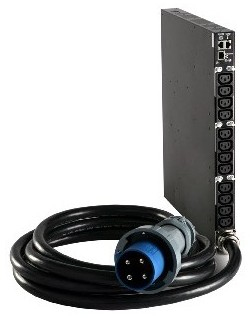These new PDUs also combine receptacle density with advanced intelligent power management capabilities that seamlessly integrate with IBM Systems Director Active Energy Manager Version 4.3 or later. Switched and Monitored PDU models don't just monitor the incoming power of the PDU, but also provide a more granular and precise view of power usage at the individual receptacle level
A power distribution unit (PDU) is a highly reliable, multiple outlet power strip designed to consolidate line cords within the rack and distribute conditioned power from a UPS or utility power to servers and other IT equipment. The PDU efficiently distributes power within the rack and provides fault-tolerant power redundancy for high availability requirements.
There are three types of PDUs available from Lenovo: basic, monitored, and switched and monitors. The PDUs covered in this document are of the switched and monitored type
Basic: The simplest and most cost-effective power distribution. Available with various outlet configurations and line cord options to support differing systems and load requirements.
Monitored (also known as PDU+): Provides the same benefits as a Basic PDU, but adds additional advanced PDU power monitoring down to the load group. This enables businesses to have a cross-platform rack level power and thermal view for trending analysis to improve power management
Switched and Monitored: These are next-generation advanced power management solutions, providing power monitoring at the outlet level, with increased accuracy at low amperages, for more precise views of power consumption down to the individual component/server level instead of at the consolidated load group. These PDUs also offer individual outlet switching (on/off), which allows for remote power sequencing and helps prevent unintended PDU overloading. Management can be performed by tools such as IBM Systems Director Active Energy Manager
Active Energy Manager (AEM) is an extension to IBM Systems Director that provides simplified management of power consumption across multiple systems. AEM has both no-charge (free) monitoring functions and optional chargeable (fee-based) management functions. Monitoring functions include power trending, thermal trending, and intelligent PDU support. Fee-based management functions include power capping and power savings mode. AEM also provides a source of energy management data that can be exploited by Tivoli enterprise solutions such as IBM Tivoli Monitoring and IBM Tivoli Usage and Accounting Manager
Results 0
- Reviews
- Write Review
- Questions and Answers
- Ask Question















